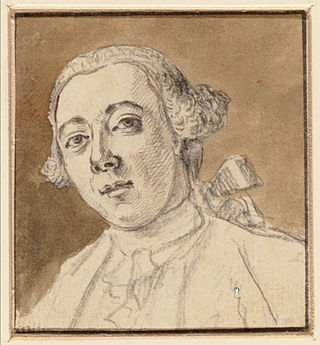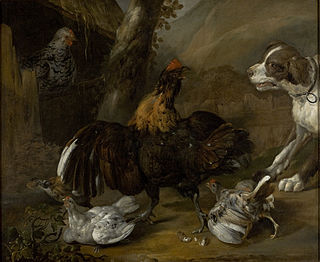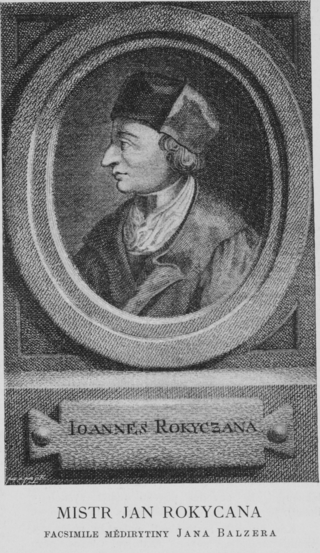Lorenzo Feliciati (1732–1799) was an Italian painter, born and active in Siena. Several pictures by this artist are to be found in the churches of Siena and its neighborhood. He painted for the church of San Pellegrino, Siena.

Matthias de Visch or Matthijs de Visch was a Flemish painter of history paintings and portraits.

Eduard Magnus was a German painter, primarily known for portraits.

Jan Maurits Quinkhard was an 18th-century painter and print designer from the Northern Netherlands.

Johannes Baptista van Acker (1794–1863) was a Flemish painter.

Adriaen, or Jan van Alen (1651–1698) was a Dutch painter from the Northern Netherlands. He was born as the son of the animal painter Jacob van Oolen in Amsterdam, with whom his works are sometimes confused. He became an imitator of Melchior Hondekoeter, and his pictures, like those of that master, represent fowls, landscapes, and still-life.

Johann Balzer was an 18th-century Czech engraver in the Kingdom of Bohemia.

Arnold van Boonen was a Dutch portrait painter.

Jean Bondol, also known as Jean de Bruges, Jean Boudolf, or Jan Baudolf, was a Flemish artist who became a court artist of Charles V of France in 1368. He is documented as active between 1368 and 1381.

Abraham Casembroot, was a painter from the Low Countries, active in Sicily.

Louis Bernard Coclers was a Southern Netherlandish portrait painter and engraver who worked mainly in Liège, Maastricht, Leiden and Amsterdam.

Heinrich Anton Dähling was a historical and genre painter born in Hanover. In 1794 he went to Berlin, where he was engaged in miniature painting and as a teacher of drawing. In 1802 he visited Paris, and the study of the galleries there first induced him to attempt painting in oil. From 1811 until his death he was a member of the Berlin Academy, and professor at the same from 1814 onwards. He died at Potsdam on 10 September 1850. One of his most famous pictures is The Descent from the Cross, the altar-piece at the Garrison Church in Potsdam. In the Berlin Gallery is a State Entry painted by him.

Adriaan de Lelie was a Dutch painter.

Adriaen van Diest (1655–1704) was a Dutch painter, who worked in England.

Anton Josef Dräger, also known as Joseph Anton Draeger, a historical painter, was born at Trèves in 1794, and died at Rome in 1833.

Marc van Duvenede was a Flemish painter, born at Bruges. He went to Rome when he was very young, and became a scholar of Carlo Maratti, in whose academy he studied four years. There are several of his pictures in the churches and convents of his native city, of which the most esteemed is the 'Martyrdom of St. Laurence' in the chapel of St. Christopher. He died at Bruges in 1730.
Roeland van Eynden was a Dutch painter. He was born at Nymegen in 1747, and died at Dordrecht in 1819. Like his brother he devoted but a portion of his time to painting, and is principally known by his works on art and artists, of which the most important is the Geschiedenis der Vaderlandsche Schilderkunst, written in conjunction with Van der Willigen, and published in 1816–1842.
Jan Baptist Francken was supposed to be a painter from the Francken family and/or the son of Sebastian Vrancx, but is now considered to have been an error and to have never existed. The confusion was created by the many painters named Francken, some poor attributions, and a portrait by Anthony van Dyck of a certain Johannes Baptist Franck, aged 32, of whom nothing more is known. He is sometimes said to be the same as Hans Francken, another obscure member of the same family.

Alexander van Gaelen (1670-1728), who was born at Amsterdam, was the scholar of Jan van Huchtenburgh, and, like his master, painted battles and subjects of the chase, which he treated with great fire and spirit. Whilst he was a pupil of Huchtenburgh, he had an opportunity of improving his touch by copying the works of Wouwerman, Berchem, and other eminent masters, as his instructor was a dealer in pictures as well as a painter; and he was perhaps more indebted to this circumstance, than to the lessons of Huchtenburgh. He soon found himself able to dispense with further instruction, and, resolving on visiting other countries in search of improvement, went to Germany, where he passed some time at Cologne, in the employment of the Elector. After a few years passed in Germany he returned to Holland, where, not meeting with the encouragement he expected, he did not long remain, but determined to visit England, whither some of his pictures had preceded him. He accordingly came to this country in the reign of Queen Anne, and is said to have painted a picture of Her Majesty in a coach drawn by eight horses, and attended by several of the nobility. He also painted three pictures, representing two of the principal battles between the Royal Army and that of the Commonwealth in the time of Charles I, and the Battle of the Boyne. No mention, however, is made of Van Gaelen in Walpole's Anecdotes. He died in 1728.

Franciscus Joseph Octave van der Donckt was a Flemish portrait painter, miniaturist and pastellist. He is also referred to as Jozef Angelus Van der Donckt, as well as several other variations, too numerous to list.
![The Pandreitje [nl], 1778, now in the Groeningemuseum Jan Antoon Garemijn - The Pandreitje in Bruges - WGA08468.jpg](http://upload.wikimedia.org/wikipedia/commons/thumb/4/41/Jan_Antoon_Garemijn_-_The_Pandreitje_in_Bruges_-_WGA08468.jpg/275px-Jan_Antoon_Garemijn_-_The_Pandreitje_in_Bruges_-_WGA08468.jpg)
















